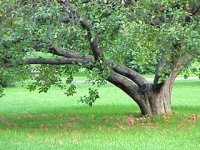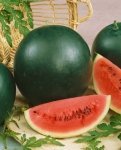Homegrown Harvest
We're finally tasting the treasures we've worked so hard to grow in the garden. However, some beginning gardeners don't know when to pick their delights, since they've always purchased them at the store. A basic change of perspective is needed. Now that you have the choice of when to harvest, let it be at the perfect moment of ripeness. This is the real payoff to growing your own. You'll bite right into that just-picked tomato, savoring its warmth and flavor, relishing the juice running down your chin.
Here are some clues to helping your plants give you their best:
- Pinch back herbs to encourage branching, and use the clippings either fresh or dry. Their flavor is at its peak just before flowering. Harvest them early in the morning after the dew has dried but before the day becomes warm and the fragrant oils dissipate. If you can smell them, it's too late; wait till the next day. Dry and store whole herb plants by using drawstring net bags from store-bought apples, onions, and potatoes. Draw the string closed, and hang the bags on hooks. The netting allows air circulation but contains most dry crumbled pieces if the bag is bumped.
- Place ripening melons onto upside-down aluminum pie pans or cans to keep them off the damp soil. The reflected heat and light will help them ripen evenly and sooner than when they are shaded by foliage.
- Harvest beans, cucumbers, squash, and tomatoes at least every other day to encourage further production. Once plants have done their reproductive job, they'll quit, so it's up to you to keep their fruits picked so the plants continue producing more blooms to be fertilized.
- Slip 8-inch sections of old pantyhose over grape clusters, tying the top and bottom with twist-ties or string in a bow. They keep out assorted insects and birds but are easy to remove for harvesting and can be reused each year.
- If onion and garlic foliage has not yet slumped and dried, stop irrigating, and bend the stalks to the ground. Allow a month or so for them to dry prior to harvest. Avoid bruising the bulbs during harvest, and let them cure in a single layer on slats or screens in a dry, well-ventilated place. They're ready to store when the foliage and outer layers are dry and papery. Store the bulbs in a cool, dry place where air can circulate. Any with soft, thick necks or bulbs that are not thoroughly dried should be used first, as they will spoil in storage. Check the stored batch once a week, and toss or use immediately any that begin to spoil.
- Preserve peppers as soon as they're harvested. Quick-freeze them by slicing or dicing the whole peppers, spreading the pieces on a cookie sheet, and freezing them. Pack the frozen pieces into larger containers, and use the pieces as desired. They will lose their crispness when they've thawed, but they're fine for recipes to be cooked.
- To dry chili peppers, pick them when they're deep red, and hang them in a sunny place until they're brittle. To dry other types of peppers, cut the larger ones in half or into pieces, or slit smaller-sized whole ones. Dry them until they're brittle. Store dried peppers in moisture- and vapor-proof containers in a cool, dry, dark place.
- Once you've had your fill of eating fresh tomatoes, freeze whole ones for cooking later. After slight thawing, cut out the core, and squeeze from the blossom end. The pulp will emerge easily and can be used in any recipe.
- Make quick, thick tomato sauce with little cooking. Puree whole, unpeeled tomatoes, and freeze the pulp in a narrow-topped container such as a plastic water jug. As it freezes, the clear liquid in the juice will separate and rise to the top of the container. When you're ready to make the sauce, remove the cap and turn the container upside down in a bowl to defrost. The clear liquid will melt before the pulp does, and the longer you allow the liquid to drain, the thicker the sauce remaining in the jug will get. Use this nutrient-rich clear liquid as a soup base.
Read more from The National Gardening Association.








